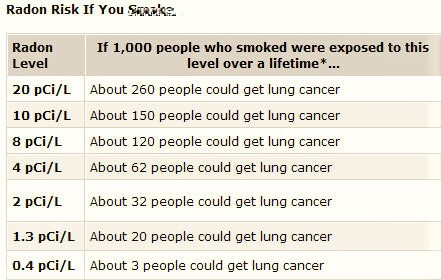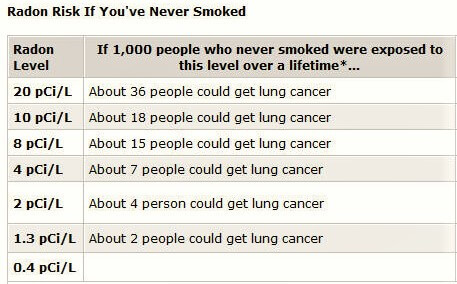Radon is an odor-free, translucent gas that is shaped from the natural break down of uranium in the earth. Although you can’t see it or notice it, radon can get into your house through cracks in your foundation, well water, building materials and other sources, where it can poison the air flow you inhale.
Due to the fact radon is radioactive, it’s also cancer causing; radon direct exposure is the second major trigger of lung cancer in the Usa, second only to cigarette smoking.
Testing your home for radon is simple, and if levels are elevated there are ways to reduce them to protect your health.
You Wouldn’t Live in a Home Without Smoke Detectors, Would You?
Most people are diligent about maintaining working smoke detectors in their home in order to prevent being injured or killed by a fire. Radon gas actually kills more than seven times the people each year as home fires, but many completely neglect to test their home for this “silent killer.” The U.S. Environmental Protection Agency (EPA) estimates that 21,000 people die each year in the United States from radon-induced lung cancer, compared to 2,800 who die in home fires.
Any home, whether new or old, with a basement or without, well-insulated or drafty, can have a radon problem; the EPA estimates that nearly 1 out of every 15 homes has elevated levels. Radon is measured in “picocuries per liter of air,” or “pCi/L.” Outdoor air generally has radon levels of about 0.4 pCi/L, whereas the average radon level indoors is estimated to be about 1.3 pCi/L. While the U.S. Congress has set a long-term goal stating that indoor radon levels should be no higher than outdoor levels, the EPA recommends taking action only if your home’s levels exceed 4 pCi/L.
This does not necessarily mean that 4 pCi/L is “safe,” however, as there really is NO safe level for radiation. Even the EPA admits that lower levels can still pose a health risk, and you may want to take precautions to further reduce the amount of radon in your indoor space even if it’s at or below 4 pCi/L.
Is There a Way to Gauge Your Risk of Radon Exposure?
You and your family are exposed to radon in your home, at the office, at school, in commercial buildings — inside every structure you enter. Radon in the outside air disperses before it reaches high levels of concentration, but in tightly sealed or poorly ventilated indoor spaces, even low levels of radon can accumulate and pose a significant health hazard.
Your radon exposure risk will depend on:
- The levels of radon in your indoor environments
- The amount of time you spend in those environments
- Whether or not you are a smoker (if you smoke and live in a home with elevated radon levels, your risk of lung cancer is particularly high)
Soil radon levels vary widely across the United States and depend on the geology of the area. Regions of the Mid-Atlantic States and the upper Midwest tend to have higher radon levels than those found in the southeast and west into Texas, and along most of the west coast.
You can find out what the natural radon levels are in your area using the EPA’s radon map — but keep in mind that elevated radon levels have been found inalmost every state, so be careful not to make assumptions about the safety of your own home based on this map. You will still need to measure the radon levels in your home or office to determine whether or not you may be exposing yourself and your family to dangerous levels.
The radon gas emitted by soil and rock can seep into buildings through gaps in the foundation, construction joints, and through cracks in floors and walls. Since radon levels are highest in rooms closest to the ground, if you spend a lot of time in basement rooms at home, work or school, your risk for exposure could be greater.
Naturally, your radon exposure is likely to be very high if you work in an underground mine (uranium and some other types as well) or a uranium processing facility, if you live near a uranium mine (although few facilities are still in operation), or if you come in contact with phosphate fertilizers. You can also be exposed to radon gas through drinking water. As the radon is released from the water into the air, you can inhale it into your lungs.
The risk of exposure from water is generally minimal, unless you happen to use a deep, underground well sunk into rock with a high radium concentration. Water from such a well could have a high level of radon, but surface water from lakes and rivers has very low radon levels.
I would encourage you to test for this poison if you get your water from an underground well. Most municipal water supplies do not contain radon. If you’re interested, you can purchase a test kit for Well Water .
Where Does Radon Come From, and How Does it Cause Cancer?
As mentioned, radon in your home can originate from a number of sources, including outside air that seeps into your home through cracks in the foundation, walls and floors, as well as your well water. Radon exposure can also come from certain building materials, including:
Read also: 4 Common Household Products to be Banned Because They are Believed to Cause Skin Cancer!
- Silicone-rich magmatic rocks, particularly granite, and especially the more exotic granites like the red, pink and purple varieties
- Gypsum waste products
- Cement and concrete
- Pumice
- Basaltic rock
Certain smoke detectors, particularly the ionization type (which are less expensive and more commonly used than the photoelectric type), emit small amounts of radon, as do certain clocks and watches. If you own a new or relatively new watch with a luminous dial, it probably contains either Tritium, a radioactive form of hydrogen, or Promethium, a man-made radioactive element. Both elements emit small amounts of radon, and while most of it is contained in the cover of the watch, there is still a minimal risk associated with having luminous watches around.
If you happen to own a World War I vintage “glow in the dark” clock or watch, be aware that highly radioactive radium was used to make the luminous paint for the dials. Wearing such watches, and certainly repairing them, poses a significant risk of radon exposure.
If you’re wondering what makes radon so dangerous, it’s the breakdown products, also known as radon progeny or the daughter products of radon, that can cause disease. These are a series of solid elements including lead-214, polonium-214 and polonium-218, which give off alpha particles of radiation. Alpha particles, unlike gamma radiation, cannot penetrate the tissues of your body from the outside. However, when inhaled or ingested, these low-dose radioisotopes accumulate in the body and exert chronic damaging effects to the DNA of your cells which contributes to a wide range of diseases, most notably cancer.
According to the EPA, if 1,000 smokers were exposed to the “action” radon level of 4 pCi/L over a lifetime, about 62 of them would get lung cancer from the radiation, compared to about 7 out of 1,000 non-smokers. The EPA’s charts below give you an idea of your cancer risk from various radon exposures depending on if you’re a smoker or a non-smoker:


How to Test Your Home’s Radon Levels
Radon gas can be deadly and is present in nearly all the air we breathe. Testing is simple and inexpensive, so I strongly encourage you to investigate how much of this gas you and your family are exposed to, and take the necessary steps to remediate the problem if the levels in your home are excessive.
See also: These Air Purifying Plants Will Not Let You Breathe Dirt, Suggests NASA
There are a number of factors that can cause indoor radon concentrations to vary, such as the use of ventilation systems, the weather, and anything that impacts indoor air pressure, such as window openings, window fans, driers, and fireplaces. The EPA recommends you take a short-term test and if your result is 4 pCi/L or higher, follow-up with either a long-term test or a second short-term test. A long-term test will give you a better understanding of your year-round average radon level, but if you need results quickly (such as if your first short-term test came back at dangerously high levels), take a short-term test.
There are a number of resources for test kits:
- If you’d like a certified technician to measure the radon levels in your home or other indoor environment, you can contact the American Association of Radon Scientists and Technologists. Testing costs from $100 to $300.
- You can also obtain information on certified technicians and do-it-yourself testing from the EPA. State and regional information can be found there.
- The National Radon Program Services at Kansas State University offers discounted test kits available to purchase online.
- Other do-it-yourself test kits for radon run between $20 and $30 and can be purchased online and at your local hardware store.
If your home has elevated radon levels, it’s important to find a qualified radon service professional to fix your home immediately. Some U.S. states maintain lists of contractors that have met certain qualifications for radon mitigation; your state radon coordinator will have this information. There are also two privately run national radon programs that can help you find a qualified radon service professional:
- The National Environmental Health Association (NEHA)
- The National Radon Safety Board (NRSB)
Finally, Kansas State University maintains national radon hotlines:
- National Radon Hotline: Purchase radon test kits by phone.
1-800-SOS-RADON (767-7236) - National Radon Helpline: Get live help for your radon questions.
1-800-55RADON (557-2366) - National Radon Fix-It Line: For general information on fixing or reducing the radon level in your home.
(800) 644-6999
There are a variety of ways to reduce radon levels in your home, including:
- Sealing cracks in floors and walls
- Increasing ventilation through sub-slab depressurization with pipes and fans
- Removing granite countertops if they are emitting high levels of radon
- Replacing ionization smoke detectors with the photoelectric type
The cost of radon reduction measures depends on the size and design of your home and the specific methods needed. Costs range from $800 to $2,500, with an average cost of $1,200. Radon reduction systems may be able to reduce your home’s radon levels by 99 percent.
If you’re building a new home or other structure, insist on building materials that are more resistant to the naturally occurring radon in the outdoor environment. The five basic features of a radon-resistant home are:
- Gravel laid below the foundation, which allows radon in the soil to circulate freely underneath your house
- Plastic sheeting or other vapor retarder laid over the gravel to stop soil gases from entering the structure
- Vent pipe run vertically from the gravel layer up to the roof to safely vent radon from the soil outside the house
- Sealing and caulking of all cracks, crevices and other openings in the concrete foundation and the walls of the structure
- Electrical junction box installed in the attic for use with a vent fan, should one be needed
Generally speaking, once your home’s radon issues have been fixed, you should re-test your home every two years. It’s a good idea to re-test your home regularly even if your levels were not elevated to begin with to be sure the levels remain low. This is yet another simple way to protect and take control of your health.
Source
Source
-http://familylifegoals.com/radon-gas-in-home/
-http://articles.mercola.com/sites/articles/archive/2012/05/14/radon-exposure-causes-lung-cancer.aspx
 Freshsein
Freshsein